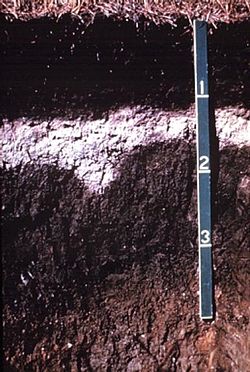Albeluvisols
| Albeluvisols | |
|---|---|

an Albic horizon
|
|
| Used in | FAO soil classification |
| Climate | subarctic, humid continental |
An albeluvisol in the FAO World Reference Base for Soil Resources is a soil with a thin, dark surface horizon on a bleached subsurface horizon (an albic horizon) that tongues into a clay illuviation (Bt) horizon. The Bt horizon has an irregular or broken upper boundary resulting from the tonguing of bleached soil material into the illuviation horizon. Albeluvisols correlate with Glossaqualfs, Glossocryalfs and Glossudalfs in the USDA soil taxonomy.
These soils are formed mostly in unconsolidated glacial till, lacustrine or fluvial materials or aeolian deposits such as loess. They occur on flat to undulating plains under coniferous forest or mixed forest in boreal and temperate climates with cold winters and short cool summers.
The agricultural suitability of Albeluvisols is limited because of their acidity, low nutrient levels, tillage and drainage problems. In northern regions there is also a short growing season and severe frost during the long winter. The Albeluvisols of the northern taiga zone are almost exclusively under forest with small areas used for pasture or hay fields. In the southern taiga zone, less than 10 percent of the non-forested area is used for farming. In the southern and western parts of the taiga in Russia arable crops, such as cereals, potatoes, sugar beet and forage maize, are found, especially on soils with higher base saturations in the subsoil.
...
Wikipedia
